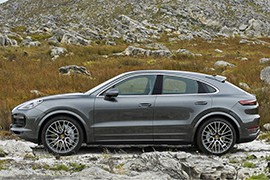PORSCHE Cayenne Turbo Coupe Models/Series Timeline, Specifications & Photos
First production year: 2019
Engines: Gasoline
Body style: SUV (Sports Utility Vehicle)
Creating a sportier-looking Cayenne was a big challenge for Porsche, but in terms of engineering and performance, it had no doubts when it introduced the Cayenne Coupe Turbo in 2019.
Porsche finally joined the club of sporty-looking SUV coupes in 2019, more than a decade after BMW introduced the X6 on the market. Meanwhile, Mercedes-Benz joined the coupe-shaped full-size crossovers bandwagon with the GLE Coupe as well. But Porsche didn’t rush. It cautiously developed the car and unveiled it at the Shanghai Auto Show. The new model was met with mixed feelings by the brand’s fans, although it soon became clear that the car hit the sweet spot for many customers. Unfortunately, in 2020, the pandemic started, and that affected sales for at least two years. After that, the sales bounced back, and the most desirable version of this coupe-shaped SUV was the Cayenne Turbo.
Like its Cayenne sibling, the Turbo Coupe featured a front fascia with triangular LED headlights and a hood that resembled the one from the Panamera, with a slightly raised center section. On the bumper, the automaker installed a broad grille extended from side to side and divided into three sections. The outer ones sported the twin-blade LED daytime running lights. Lower, on the apron, the Cayenne Turbo featured a slim center air intake and two black side scoops.
Porsche redesigned the car’s exterior with a one-inch (20 mm) lower roof, which led to a flatter windshield. The raked-forward tailgate continued the sloped-down roofline at the back, which sported a retractable spoiler below the rear window. Unlike the regular Cayenne Turbo, the Cayenne Turbo Coupe had its license plate mounting area relocated from the tailgate to the bumper, emphasizing the car’s sporty look. Since this was the top-of-the-range version in the stable, it was fitted as standard with a panoramic glass roof, but customers could get the vehicle with a carbon fiber fixed roof instead when choosing the Sport Pack, which greatly reduced the car’s gravity center and also added a 22-inch set of light-alloy wheels.
Inside, Porsche installed a set of high-bolstered bucket seats at the front with an option for sports ones with integrated headrests. The driver fronted a four-dial mixed digital/analog display. Like on many other Porsches from that era, the Cayenne coupe had the tachometer in the middle and a large display on the right that showed data from the car’s onboard computer. Porsche installed a 12-inch touchscreen on the center stack for the infotainment system. In the back, the automaker installed two individual seats instead of a regular three-seat bench seat. Still, due to the sloped roof line, headroom was not as generous as in a regular Cayenne.
Under the hood, the car manufacturer installed the same 4.0-liter twin-turbo V8 engine as in the Cayenne Turbo. It paired it with an eight-speed automatic gearbox that sent the power in all corners. In terms of performance, the Turbo Coupe played in the supercar territory.
